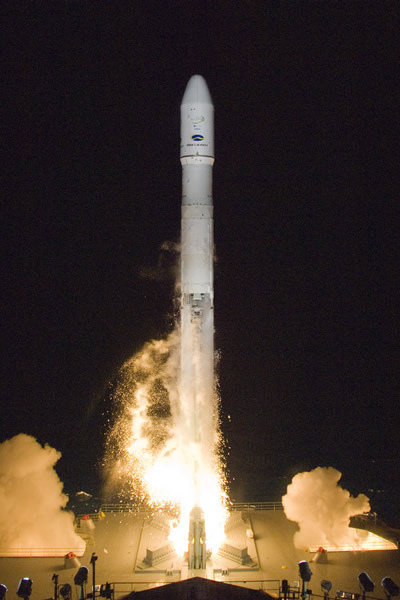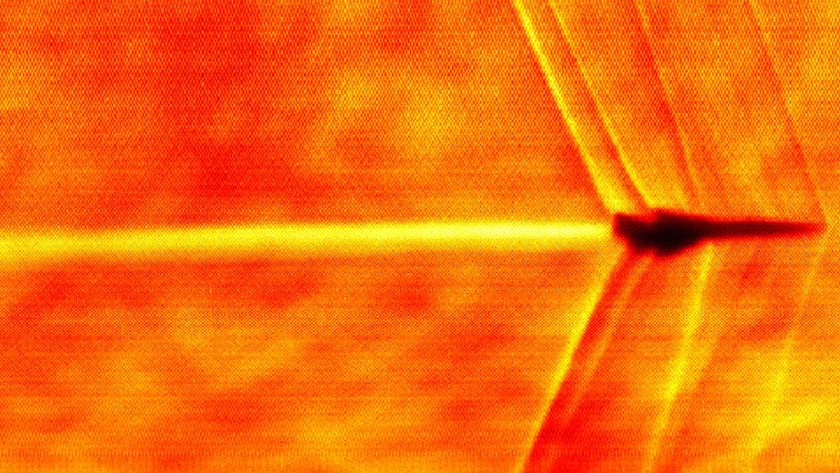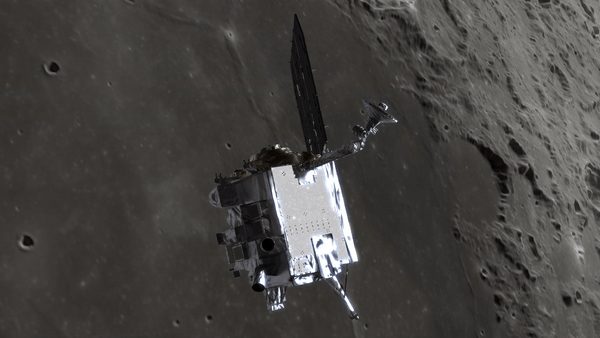Sea Launch Deploys New Galaxy for North America

A communications satellite that will broadcast a range ofinternational television channels to North America was sent into space today toreplace the aging spacecraft currently doing that job.
A commercial Sea Launch Zenit 3SL booster began itssuccessful 63-minute ascent carrying the Galaxy 19 spacecraft from a convertedoil-drilling platform positioned in equatorial waters of the Pacific about1,400 miles south of Hawaii. Liftoff occurred at exactly 0927:59.108 GMT(5:27:59.108 a.m. EDT).
"Another fantastic launch," said Kjell Karlsen,president and general manager of Sea Launch. "It's what we call a veryboring launch, which is very good. Everything was right on target."
The two Ukrainian-made lower stages of the rocketperformed their firings to propel the Russian Block DM-SL upper stage andGalaxy satellite out of the atmosphere during the initial eight-and-a-halfminutes of flight.
The upper stage then took over, completing an initialengine burn to reach a preliminary orbit about 17 minutes after launch. Therocket coasted for a half-hour, flying over South America, before re-ignitingfor a three-minute firing to accelerate the payload into an ellipticalgeosynchronous transfer orbit with a high point of 22,149 miles and low pointof 1,746 miles.
The Galaxy 19 satellite will use an onboard engine to reacha circular geostationary orbit 22,300 miles above the equator where it canmatch Earth's rotation and seem parked over one spot of the globe. That slotwill be 97 degrees West longitude where it will replace the 11-year-old Galaxy25 spacecraft, formerly known as Telstar 5.
"This satellite will provide our customers valuable50-state coverage in addition to reaching the Caribbean, Canada andMexico," said David McGlade, Intelsat's CEO.
Get the Space.com Newsletter
Breaking space news, the latest updates on rocket launches, skywatching events and more!
"Once operational, Galaxy 19 will host the largest internationalvideo programming platform in North America, providing distribution of news andentertainment to our customers who serve the ethnically diverse audience ofthis region. Likewise, Galaxy 19 will offer our government and networkcustomers refreshed capacity, with seamless data communications for years tocome."
The 10,340-pound satellite was built by SpaceSystems/Loral using the 1300-series spacecraft design. It is equipped with acommunications package of 52 transponders in C-band and Ku-band.
"We expect to see the spacecraft working flawlesslyfor over 20 years," said Ken Lee, Intelsat's vice president of spacesystems.
This is the 43rd satellite constructed by SpaceSystems/Loral to enter Intelsat's in-orbit fleet.
"We have been delivering satellites to Intelsat forover 25 years," said John Celli, president and chief operating officer ofSpace Systems/Loral.
Galaxy 19 marked Intelsat's 8th flight with Sea Launchand the second this year, following the Galaxy 18 craft's deployment in May.
"I was here four months ago and, just like today, itwas another flawless mission," said Lee.
Galaxy 19 will join Intelsat's North American Galaxyfleet comprised of 16 other satellites that cover North and Central America,plus the Caribbean.
"Globalization of content continues to be asignificant driver for industry growth, creating demand for satellite capacity.Because of the global society we live in today, being able to watch regionalprogramming from other countries or special events such as the Olympic Gamesremains paramount, especially for the ethnically diverse audience in NorthAmerica," said McGlade.
This was the fifth and final Sea Launch mission of theyear. The next ocean-going liftoff is targeted for January to loft Italy'sSicral 1B military telecommunications satellite.
Earlier this summer, Spaceflight Now visited Sea LaunchHome Port in Long Beach, California. See our exclusive photo galley hereand an overview of Sea Launch operations here.
- Video - Falcon 1's Third Flight
- Video ? Suborbital Rocket Test Explodes
- Future of Flight: Space Tourism, Investment and Technology
Copyright 2008 SpaceflightNow.com,all rights reserved.
Join our Space Forums to keep talking space on the latest missions, night sky and more! And if you have a news tip, correction or comment, let us know at: community@space.com.
Justin Ray is the former editor of the space launch and news site Spaceflight Now, where he covered a wide range of missions by NASA, the U.S. military and space agencies around the world. Justin was space reporter for Florida Today and served as a public affairs intern with Space Launch Delta 45 at what is now the Cape Canaveral Space Force Station before joining the Spaceflight Now team. In 2017, Justin joined the United Launch Alliance team, a commercial launch service provider.












